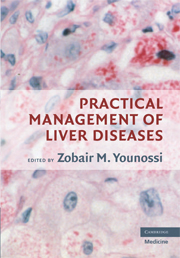Book contents
- Frontmatter
- Contents
- Preface
- Contributors
- 1 Acute Viral Hepatitis
- 2 Chronic Hepatitis B and D
- 3 Chronic Hepatitis C
- 4 HIV and Viral Hepatitis
- 5 Nonalcoholic Fatty Liver Disease
- 6 Alcoholic Liver Disease
- 7 Genetic Hemochromatosis and Iron Overload
- 8 Wilson's Disease
- 9 Alpha-1 Antitrypsin Deficiency and the Liver
- 10 Autoimmune Liver Disease
- 11 Drug-Induced Liver Disease (DILI)
- 12 Benign and Malignant Tumors of the Liver
- 13 Complications of Cirrhosis
- 14 Liver Transplantation
- 15 Novel Technologies in Studying Chronic Liver Disease
- Index
- References
7 - Genetic Hemochromatosis and Iron Overload
Published online by Cambridge University Press: 08 August 2009
- Frontmatter
- Contents
- Preface
- Contributors
- 1 Acute Viral Hepatitis
- 2 Chronic Hepatitis B and D
- 3 Chronic Hepatitis C
- 4 HIV and Viral Hepatitis
- 5 Nonalcoholic Fatty Liver Disease
- 6 Alcoholic Liver Disease
- 7 Genetic Hemochromatosis and Iron Overload
- 8 Wilson's Disease
- 9 Alpha-1 Antitrypsin Deficiency and the Liver
- 10 Autoimmune Liver Disease
- 11 Drug-Induced Liver Disease (DILI)
- 12 Benign and Malignant Tumors of the Liver
- 13 Complications of Cirrhosis
- 14 Liver Transplantation
- 15 Novel Technologies in Studying Chronic Liver Disease
- Index
- References
Summary
BACKGROUND
Hereditary hemochromatosis (HH) is a common inherited disorder of iron metabolism that can lead to excess iron deposition in the liver, heart, pancreas, joints, and skin leading to functional insufficiency and organ damage. Much has been learned about the phenotypic expression of hemochromatosis over the last several years and our knowledge of cellular iron metabolism has advanced considerably since the discovery of HFE, the gene mutated in the majority of patients with HH. Also, it has become increasingly apparent that patients with other common liver diseases (chronic viral hepatitis, alcoholic liver disease, nonalcoholic fatty liver disease) frequently are complicated by mild to moderate degrees of secondary iron overload. A high prevalence of patients with the genetic defect for hemochromatosis (either C282Y or H63D mutation) has been found in patients with porphyria cutanea tarda (PCT) consistent with the knowledge for many years that iron reduction has played a role in the treatment of PCT.
In this chapter, I will describe the epidemiology and pathogenesis of hemo- chromatosis and outline the steps necessary for diagnosis, treatment, and screening for hemochromatosis.
IRON OVERLOAD SYNDROMES
Current classification of iron overload syndromes divides these patients into three groups: (1) those who have inherited causes of iron overload, (2) those who have various causes of secondary iron overload, and (3) a small miscellaneous group. Approximately 85–90% of patients who have inherited forms of iron overload are homozygous for the C282Y mutation in HFE or are compound heterozygotes, meaning that one allele has the C282Y mutation and one allele has the H63D mutation.
- Type
- Chapter
- Information
- Practical Management of Liver Diseases , pp. 117 - 130Publisher: Cambridge University PressPrint publication year: 2008



